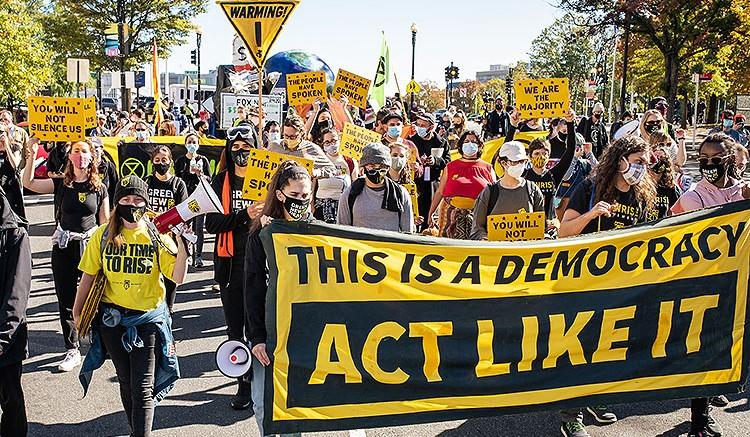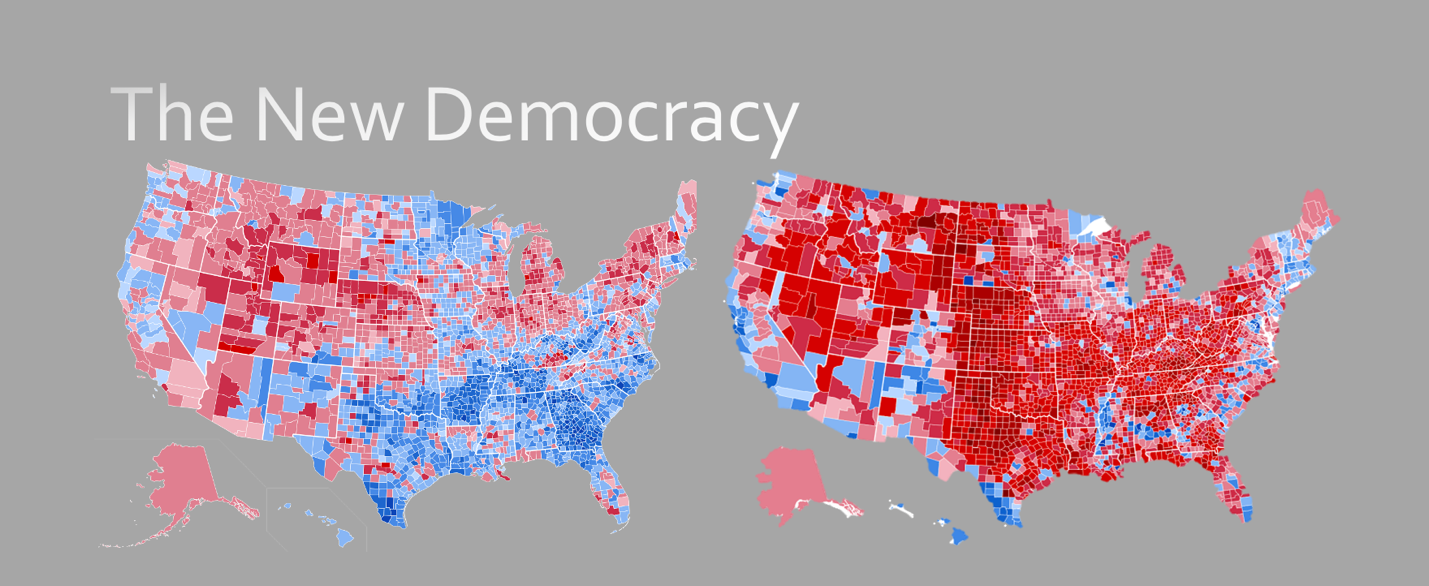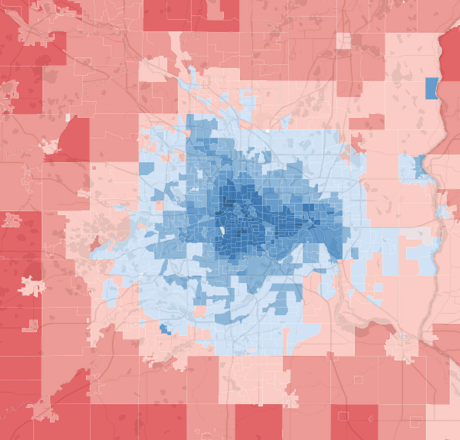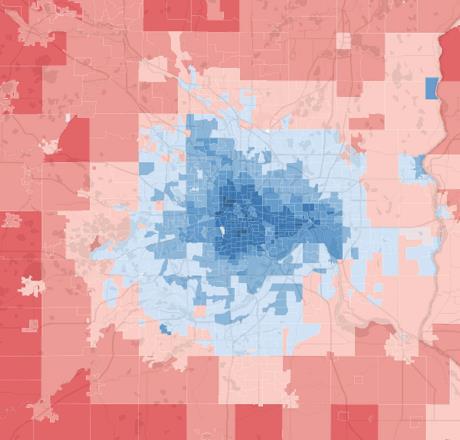A golden age of democracy
Let me state a bold claim: This is a golden age of democracy.
That runs counter to the conventional wisdom of the last four years that there is a rising tide of authoritarianism sweeping across the globe, and especially the United States. Sure, authoritarian leaders have been elected in countries worldwide, and many of their supporters no doubt are authoritarians themselves: Studies in the United States of supporters of Donald Trump find high correlation with authoritarian attitudes and desire for a “strong leader” during these troubling times.

But support for Trump, and other such politicians, cannot be attributed wholly to authoritarian leanings: Many Americans actually like his fairly standard-Republican economic policies, such as deregulation and (ostensibly) lower taxes, and credit him with three years of continued economic expansion while dismissing the pandemic-induced depression as not his fault. Meanwhile, Trump’s support amongst African Americans actually rose in 2020 over four years earlier, and increased significantly as well amongst Hispanics and all Americans of color (although still a minority of all these groups).[1]
While authoritarians themselves have been on the ascendance in many countries the last few years – not to mention pre-existing autocrats in others – there also has been widespread democratic opposition in virtually all these countries. Street protests and organized oppositions to authoritarians and would-be authoritarians have surged worldwide, from Russia, Hong Kong, and Venezuela, to threatened democracies such as Thailand, the Philippines, Hungary, Poland, and the U.S.. Right-wing parties lost power in Italy and Slovakia, and their threat has receded in Germany.
Sandwiched this fall between the historic Thai protests against the monarchy and the culminating event of the U.S. presidential election were enthusiastic democratic exercises in New Zealand, where popular prime minister Jacinda Ardern was re-elected in a landslide and the leader of Bolivia’s Movement for Socialism, Luis Arce, won that country’s presidency in a rout. Both of these were notable for larger trends they underscored: Ardern, who garnered widespread praise for her healing response to the 2019 Christchurch mosque massacre by a rightwing gunman, won in large measure because of her government’s effective response to the COVID-19 pandemic. Arce was elected essentially as an avatar for ousted president Evo Morales, who became increasingly autocratic and was driven from office and into exile; a majority of voters made clear in Arce’s victory (and Morales’ likely recall) that they didn’t appreciate having their government dictated to them by the country’s elite – even if the alternative is a would-be dictator himself.
This swirl of disparate developments highlights a variety of nonetheless-interrelated themes: Anger at elites is widespread. The desire for self-determination and political democracy is not necessarily liberal or unreceptive to “strong man” rulers. In this volatile environment, there is in fact widespread attraction to extremist ideologies – and social media provide the means for publicizing and connecting their adherents in ways that previously more-centralized, mass communications media did not.
Nonetheless, most people reject these ideologies. People the world over still desire self-determination. And despite the supposed efficiency advantages of authoritarianism, democratic governments and non-authoritarian leaders have performed generally better in battling the pandemic, in large part because of the trust and social cooperation they engender – which in turn flows from their openness and honesty.
And, of course, now, the United States, the world’s most important democracy, just experienced its highest voter turnout in 120 years – following record turnout for the 2018 midterms. The Trump era, with all its democratic norm-breaking and attempted authoritarianism at the top, has generated unprecedented levels of grassroots democratic participation, from voting to massive organized demonstrations to spontaneous nationwide protest and civil disturbances unseen in a half- century. There are certainly xenophobic, intolerant, anti-democratic leaders and movements in the U.S., as elsewhere – and nearly half the population voted to keep them in place in this most recent election. But the majority did not – and even the vast bulk of those who voted for Trump believe in the democratic process and chose to express that by, well, voting.
Thus, Trump’s attempt to remain in office depends ultimately on appealing not to the inherent superiority of his leadership – the essential authoritarian argument – but rather the supposed democratic legitimacy of his election. Trump personally is clearly an authoritarian; that doesn’t mean that all his supporters are. In fact, while many view as authoritarian the right-wing populist movements worldwide that have helped to elect authoritarians like Trump or worse on almost every continent in recent years, these movements are in fact broad-based, grass-roots, and anti-elite – in short, highly democratic: They’re just not very liberal; there’s a difference.
And that points to the crucial issue: It’s necessary to define what is meant by “democracy.”
We have to date defined it too narrowly – as a particular set of political and governmental arrangements. We should view it as something much broader.
Today’s technology is making it possible for a wider range of individuals to obtain essentially what they want, tailored to their own wishes and needs. Technology has made possible mass individuation, in which large-scale consumer goods can be mass-produced but tweaked to individual needs. Clothes and shoes can be ordered custom-designed to the customer’s particular body shape. And it’s not just on the consumer side: Small-scale manufacturers can rent factory time for limited production runs, making entry easier without the need for investment in large-scale capital goods and facilities. In fact, the line between consumer and producer is thinning, as computer owners increasingly can rent out their excess computer capacity for everything from cryptocurrency “mining” to astrophysics data-crunching, homeowners can rent out their excess rooms for commercial lodging, and car owners can rent out the majority of time their cars are otherwise idle to provide rideshare services.
All of this will make capital more accessible to more people in the long-term. It is making it possible for more people to become entrepreneurs, publishers, broadcasters, and producers of all sorts, to obtain goods and services they want from anywhere at any time, and to work at whatever they want from wherever they choose. And it’s a reflection of a world in which digital technologies from the Internet to blockchain are increasingly disaggregating, decentralizing, and distributing all economic activities.
In that sense, our economy is becoming much more democratized. Other areas of life are becoming more democratized, as well, perhaps less happily, such as the use of force. One of the leading books on this subject, The Future of Violence[2], for instance recognizes the dispersion of destructive capability – through the increasing availability, decreasing cost, and continuing miniaturization of weapons technologies – as a form of “democratization.” In the near future, individuals, and certainly groups, will possess Weapons of Mass Destruction previously accessible only to nation-states. The scale of economic damage that an individual or small group of hackers can wreak today through cyberattacks can dwarf some gross domestic products. On the other hand, the Cambridge Dictionary uses “[t]he online degree program” as an example of “the purest democratization of education.”[3]
Democratization, in short, is all around us, in virtually every human activity, and rising, thanks to the ascendance of digital technologies.
But it should be clear from these non-political examples that “democratization” doesn’t necessarily mean either liberalization or the defeat of authoritarianism. The democratization of force positions non-state actors as serious threats not only to states but also to other individuals. The democratization of communications media from a mass enterprise to a “social” one has turned out to be, in fact, quite anti-social, empowering individuals to shout down and shut down those with whom they disagree, from trolling to Denial Of Service attacks. The multiplicity of information outlets is undermining authoritativeness – and authority – making it possible for everyone to live within their own perceptual reality, separating us from each other and allowing us to “cancel” those we dislike totally and permanently from our lives; the arrival of widespread virtual reality will only deepen these phenomena. The democratization of most areas of life has not fed greater tolerance or liberal behavior.
Similarly, all the aforementioned technologies have done little if anything to diminish the ancient tension between individualism and authoritarianism. In fact, it has become common to view most modern technologies as tending to the authoritarian; Yuval Harari is perhaps the leading proponent of this view.[4] Of course, when the Internet was young, it was viewed as something of a libertarian panacea that would allow everyone to escape from the boot heel of government, promote access to truth through free and unlimited information flow, and promote social interaction and the brotherhood of humankind; so much for that. But it’s equally unrealistic to see digital technologies as irremediably tyrannical: In fact, dissidents, criminals, and just-plain-average people have found ways around even the most aggressive state control and regulation of information flows, oftentimes using offshoots of the same technologies.
Nonetheless, the serious risk of an authoritarian technology future should not to be dismissed. The leading tech giants tend to monopoly; perhaps most dangerous among these is Amazon, which is essentially “fencing the commons” of the marketplace itself, turning the entire economy into its private property. Big data processing capabilities and the surveillance nature of almost all online interactions make it possible for corporations (and governments) to know you better than you known yourself, to channel and manipulate your decisions. It is arguable that in this not-so-distant future, individual choice will in fact be nothing of the sort.
In all these ways, in fact, it is increasingly difficult to distinguish these private actors from governments – which takes us to the main point: Everything that’s been said so far about every other area of human activity today is equally true of governments.
As I’ve argued elsewhere,[5] separate virtual “countries” – where we choose our policies and what we’re willing to pay for them by choosing a “provider” rather than through elections – are the probable technological end-point of our current democratization. The leading edge of this development is Estonia’s “e-Residency” program, which enables entrepreneurs from around the world to establish virtual Estonian businesses, with little-to-no physical connection to Estonia, and thereby access the Baltic country’s advanced on-line governmental services infrastructure, its light business-regulatory hand and low tax rates, and its entrée to the European market. In this new digital world, territory matters less and less. Not only can services be provided regardless of where the customer is located, but it also won’t even matter where the “government” itself is located.
As governments and their nation-states become less about territorial monopoly and more about competitive service delivery, this will bring increasing pressure from other, better governance providers. Once “customers” can start choosing amongst governmental providers, why not non-governmental providers of such services, as well? Citizens will be able to choose between “communities” for their policies instead of choosing between policies for one’s community. In fact, they largely do so already.

These maps show the county-level vote in two similarly-close U.S. presidential elections: In each, the Democratic candidate won the popular vote by roughly two percentage points. The one on the left is 1976 (Jimmy Carter vs. Gerald Ford), the right 2016 (Hillary Clinton vs. Trump): Had Clinton turned out a handful more voters in three cities – Philadelphia, Detroit, and Milwaukee – she essentially would have flipped the Electoral Vote total… but the county-level map would still look exactly the same. When the equivalent county-level appears for the 2020 election, it will look almost exactly the same, as well – with the prominent exception of Maricopa County (Phoenix), Arizona, flipping from pink to light blue.
Perhaps even more illustrative (and representative) is this map of the metropolitan area that ignited the nationwide protests over police violence this past summer – Minneapolis, Minnesota – showing the clear division between Democratic (blue) city and suburbs, and Republican (red) exurbs:
Over the last 44 years, Americans have essentially sorted themselves geographically by economics, culture, ideology and politics. The same is largely true in other countries, too.
The result is that electoral democracy hardly matters any longer, except in nationwide votes: State and local elections are largely foregone conclusions. People now choose their governments by moving – to California, say, or Idaho – not afterward in elections. The cost of moving – whether people or goods – has been declining throughout history; with digital technologies, it approaches zero. This will make it even easier for people to opt out from (or into) governments as they choose – as with other products and services. This represents a very democratic future – just not in the way we normally think of it.
In sum, Donald Trump – anti-democratic as he is – was both the product of something quite democratic and, like other authoritarians worldwide, the generator of an even more democratic reaction. All of this, including the turbulence, is part of the hyper-democratic age in which we live.
Footnotes:
[1] Public Opinion Strategies, “Key Findings: Public Opinion Strategies Election Night Surveys,” https://pos.org/wp-content/uploads/2020/11/2020-Post-Election-National-Survey-1.pdf.
[2] B. Wittes & G. Blum, The Future of Violence, https://www.amazon.com/Future-Violence-Robots-Hackers-Confronting/dp/0465089747.
[3] https://dictionary.cambridge.org/us/dictionary/english/democratization.
[4] Yuval Noah Harari, “Why Technology Favors Tyranny,” The Atlantic, https://www.theatlantic.com/magazine/archive/2018/10/yuval-noah-harari-technology-tyranny/568330/.
[5] https://www.cnn.com/2019/11/04/opinions/trump-exposes-holes-in-nation-state-schnurer/index.html.


